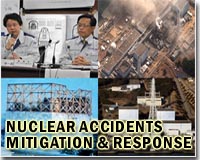| . |  |
. |
Tokyo (AFP) May 12, 2011 Japan's stricken Fukushima nuclear plant has been hit by new setbacks, its operator said Thursday, including a water leak from a reactor vessel and another spill of contaminated water into the ocean. The government ordered the cull of thousands of cattle and other livestock roaming the 20-kilometre (20-mile) evacuation zone around the nuclear plant, which was abandoned when the disaster started two months ago. Japan apologised to its neighbours about the toxic leak into the Pacific as food safety concerns widened, with Greenpeace reporting above-limit radiation in seaweed and a region south of Tokyo issuing a similar warning about tea. The update from Tokyo Electric Power Company (TEPCO) came as emergency crews battle to bring the tsunami-hit and radiation-leaking atomic plant into stable "cold shutdown" some time between October and January. The giant ocean wave triggered by the massive magnitude-9.0 seabed quake on March 11 knocked out the plant's water cooling systems, leading fuel rods inside several reactors to partially melt and sparking explosions. Workers have since doused reactors and fuel rod pools with water to stop them from overheating and releasing far greater amounts of radiation. TEPCO on Thursday said new measurements taken after workers in protective suits fixed gauges in the badly-hit reactor one building had indicated that the water pumped into the pressure vessel had quickly leaked out. The water level had fallen below the bottom end of the four-metre (12 foot) long nuclear fuel rods, leaving them fully exposed to the air. However, the vessel's relatively low outside temperature of 100-120 degrees Celsius (212-248 degrees Fahrenheit) indicated that the rods had now dropped to the bottom of the vessel and were submerged under water, TEPCO said. Environmental group Greenpeace said the news showed that at least some earlier water level readings had been entirely wrong and that "the situation is clearly far more serious than previously reported". "As the fuel rods were fully exposed and subsequently melted, it is highly likely that the core's integrity is compromised and that there is a larger amount of melted fuel at the bottom of the reactor pressure vessel," said Jan Beranek, the group's international nuclear campaign leader. TEPCO has been injecting around seven tons of water an hour into the reactor one pressure vessel and plans to flood the wider containment vessel around it. The dousing operations -- in which tens of thousands of tons of water have been injected with fire trucks, concrete boom pumps and other systems -- have created massive amounts of highly contaminated runoff water. After earlier ocean spills, TEPCO said runoff had again leaked into the sea from a concrete pit near reactor three, one of the plant's six units. Samples of seawater taken near the plant contained caesium-134 at a concentration 18,000 times the permitted level, the utility said, adding that the spill had been stopped by filling the pit with concrete. Top government spokesman Yukio Edano called the leak "deplorable" and apologised to the fishing industry and to neighbouring countries. Greenpeace, which has sent its Rainbow Warrior flagship to take samples of marine life and water off the plant, called on the government to undertake comprehensive radiation testing of seaweed along the Fukushima coast. Initial tests of 22 seaweed samples collected at distances up to 65 kilometres (40 miles) out to sea from the plant "registered significantly high levels of radioactive contamination," the group said. Ten seaweed samples showed levels of over 10,000 becquerels per kilogramme, the group said. It did not specify whether the contamination was from iodine-131 or caesium-137 -- the official safety limits for which are 2,000 and 500 becquerels per kilogramme respectively. Meanwhile, Kanagawa prefecture southwest of Tokyo said it was recalling its tea after measuring about 570 becquerels of caesium per kilogramme in leaves grown in Minamiashigara city -- compared to the legal limit of 500. "We have not specified the source of the radiation," said Kangawa agriculture official Hideto Funahashi, "but we cannot imagine any other source than the nuclear power plant."
Share This Article With Planet Earth
Related Links Bringing Order To A World Of Disasters A world of storm and tempest When the Earth Quakes
 Nuclear stigma adds to Japan's pain
Nuclear stigma adds to Japan's painFukushima City, Japan (AFP) May 12, 2011 Nuclear radiation is not the only invisible enemy threatening Japan's disaster-hit Fukushima - its people say they also face discrimination and the stigma of being "Japan's Chernobyl". While radioactive material has spewed from the stricken Fukushima Daiichi nuclear plant over nearby homes since the devastating March 11 earthquake and tsunami, locals say the psychological fallout extends mu ... read more |
|
| The content herein, unless otherwise known to be public domain, are Copyright 1995-2010 - SpaceDaily. AFP and UPI Wire Stories are copyright Agence France-Presse and United Press International. ESA Portal Reports are copyright European Space Agency. All NASA sourced material is public domain. Additional copyrights may apply in whole or part to other bona fide parties. Advertising does not imply endorsement,agreement or approval of any opinions, statements or information provided by SpaceDaily on any Web page published or hosted by SpaceDaily. Privacy Statement |